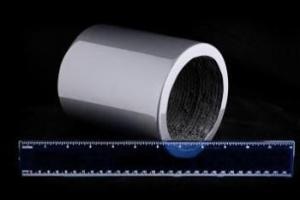Nov 2 2016
 This isotropic, neodymium-iron-boron bonded permanent magnet was 3D-printed at DOE’s Manufacturing Demonstration Facility at Oak Ridge National Laboratory. Credit: Oak Ridge National Laboratory
This isotropic, neodymium-iron-boron bonded permanent magnet was 3D-printed at DOE’s Manufacturing Demonstration Facility at Oak Ridge National Laboratory. Credit: Oak Ridge National Laboratory
A team of researchers at the Department of Energy’s Oak Ridge National Laboratory (ORNL) have demonstrated that permanent magnets developed by additive manufacturing are capable of outperforming bonded magnets made using standard methods while conserving critical materials.
Scientist used the Big Area Additive Manufacturing (BAAM) machine to fabricate isotropic, near-net-shape, neodymium-iron-boron (NdFeB) bonded magnets at DOE’s Manufacturing Demonstration Facility at ORNL. The result, featured in Scientific Reports, was a product with better or comparable microstructural, mechanical, and magnetic properties than bonded magnets produced using standard injection molding with the same composition.
The additive manufacturing technique started with composite pellets comprising of 65 volume percent isotropic NdFeB powder and 35% polyamide (Nylon-12) manufactured by Magnet Applications, Inc. BAAM was used for melting, compounding, and extruding the pellets layer-by-layer into desired forms.
Standard sintered magnet manufacturing could result in material waste amounting to as much as 30 to 50%. Whereas, additive manufacturing simply captures and reuses those materials with almost zero waste, stated Parans Paranthaman, principal investigator and a group leader in ORNL’s Chemical Sciences Division. DOE’s Critical Materials Institute (CMI) funded the project.
A process that conserves material plays a major role in the manufacture of permanent magnets developed from dysprosium and neodymium, which are rare earth elements that are first mined and then separated outside the United States. NdFeB magnets are considered to be the most powerful on earth, and they are used in everything starting from head phones and computer hard drives to clean energy technologies such as wind turbines and electric vehicles.
Paranthaman stated that the printing process helps to conserve materials and also to produce complex shapes without tooling and in a faster manner unlike standard injection methods, resulting in a much enhanced economic manufacturing process.
Manufacturing is changing rapidly, and a customer may need 50 different designs for the magnets they want to use.
Ling Li, Researcher, ORNL
Conventional injection molding will require the expense of developing a new mold and tooling for each. However, in additive manufacturing it is possible to quickly and effortlessly craft the forms using a computer-assisted design, she explained.
In the future, research will focus on exploring the printing of directional, or anisotropic, bonded magnets, which are sturdier than isotropic magnets thaT do not have a preferred magnetization direction. Researchers also aim to analyze the impact of binder type, the magnetic powder’s loading fraction, and processing temperature on the mechanical and magnetic properties of printed magnets.
Alex King, Director of the Critical Materials Institute, believes that this work has incredible potential. “The ability to print high-strength magnets in complex shapes is a game changer for the design of efficient electric motors and generators,” he said. “It removes many of the restrictions imposed by today’s manufacturing methods.”
This work has demonstrated the potential of additive manufacturing to be applied to the fabrication of a wide range of magnetic materials and assemblies. Magnet Applications and many of our customers are excited to explore the commercial impact of this technology in the near future.
John Ormerod, Magnet Applications Inc.
Contributors of the project include Ling Li, Angelica Tirado, Orlando Rios, Brian Post, Vlastimil Kunc, R. R. Lowden, Edgar Lara-Curzio at ORNL, as well as researchers I. C. Nlebedim and Thomas Lograsso working with CMI at Ames Laboratory. Robert Fredette and John Ormerod from Magnet Applications Inc. (MAI) contributed to the project through an MDF technology collaboration.
The DOE’s Advanced Manufacturing Office provides support for ORNL’s Manufacturing Demonstration Facility, a public-private partnership to engage industry with national labs.
3D-printed permanent magnets outperform conventional versions, conserve rare materials
Oak Ridge National Laboratory/Youtube.com